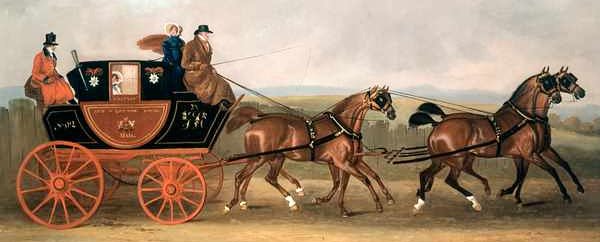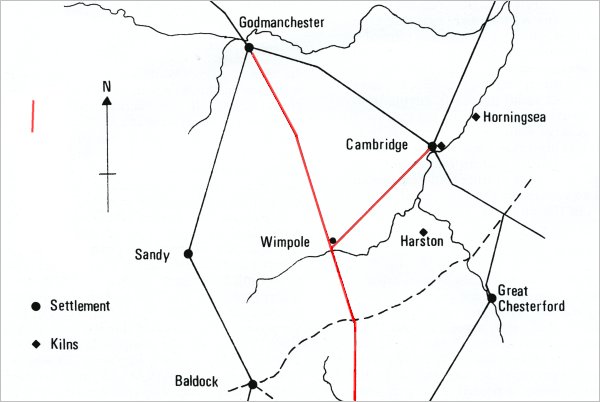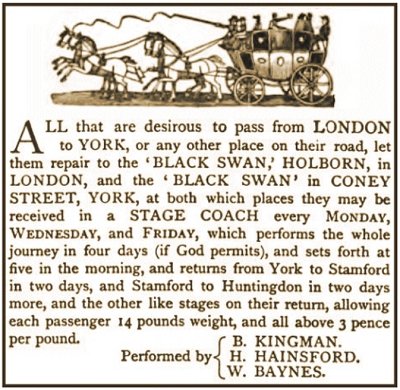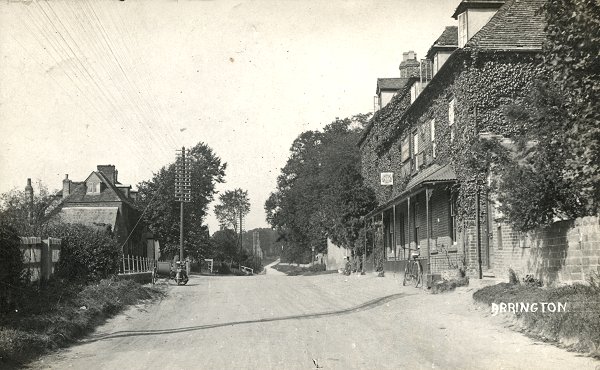 | A local history and genealogy site for Wimpole, a village and parish in South Cambridgeshire
Curated by Steve Odell
 |
 |

 |
| Ermine Street - A Brief History |
| The small village of Arrington sits astride an important Roman road, Ermine Street, an ancient
highway of historical, cultural and touristic interest which has played a significant
role in English history. |
| Ermine Street also forms [mostly] the western boundary of the Parish of Wimpole with its neighbour the Parish of Arrington. Apart from a small detour around the back of the eastern edge of Arrington village, the modern Arrington/Wimpole parish boundary follows the A1198 for the two and three-quarter miles from Arrington Bridge to Coombe Grove Farm. The exact line of the boundary meanders between both the eastern and the western edges of the carriageway but Ermine Street is almost as much Wimpole's road as it is Arrington's. |
| Roman Times |
| The original road
was Roman, and construction is thought to have began around 43 AD. The road was an important military and trade
route and ran 200 miles (322km) from Bishopsgate in London (Londinium), northwards through Ware, Royston, Arrington,
Godmanchester, and Ancaster to Lincoln (Lindum) and onwards to York (Eboracum),
crossing the River Humber at Brough. It remained "one of the great roads of England" until modern times. |
| Roman
roads were well constructed with a paved surface. Ermine Street would have allowed quick efficient
travel for military leaders, high dignitaries, merchants travelling
on business, civil servants, commercial traffic, foodstuffs moving towards the
towns from the countryside, wares from local workshops, and the distribution and delivery of raw materials to small local industries. |
| Rome's legions would have marched this way too, on their way up to York and Hadrian's Wall. |
| There
was a Roman settlement along Ermine Street at Arrington
Bridge at the strategically important and defensible ford crossing of the River
Rhee [tributary of the River Cam]. There has been some speculation that the Roman settlement was a Mutation (basic horse-changing station with some accommodations) or even a Mansio (luxury accommodation and general facilities for travellers) although the archaeological evidence is currently somewhat debatable. |
| The ford through the Rhee and the Roman settlement were situated some 200 yards south of the important road junction between
Ermine Street and Akeman Street (A603), another Roman road that ran north-eastwards to the settlement at Cambridge [Duroliponte] and on to the Isle of Ely. This road junction (where the Wimpole and Arrington War Memorial is situated) was closed off in 1990 following completion of a new roundabout a little to the north. |
| continued below |
|
 |

| Location of Wimpole in relation to the Roman Road network |
 |
| continued... |
| Saxon Road |
| We
do not even know whether our Roman road had a Roman name. 'Ermine' is of Anglo-Saxon
origin (in 1012 'Earninga Straete'). The names Arrington and Ermine are both derived from the Earningas, a group or tribe of people who lived
in Armingford [ancient district roughly covering Arrington, East Hatley, Steeple
Morden, Royston, Melbourn, Whaddon, Wimpole and points between] in Saxon and
Medieval times |
| Ermine Street also became one of the four main highways of
saxon England and can be traced back in documents to at least 955 AD. The strategic ford
at Arrington was probably the meeting-place, or moot, of the Armingford
Hundred [a sort of Saxon local parliament]. It is believed the first
bridge across the River Rhee was built here around 1285. |
| Road Upkeep |
| In
the thousand years after the Romans left, the road structure probably disintegrated
into little more than a wide muddy track. Badly maintained, if at all, the surface
would have been dry and dusty in summer - wet, muddy and frequently impassible
in winter. What little upkeep the road received would have been organised by local
landowners to maintain their own passage to towns and markets. |
| People would have usually travelled on horseback or by foot since coach
or wagon travel was difficult in all but the driest weather. Most goods and even
large quantities of industrial raw materials had to be transported by trains of
pack horses since wagons tended to become mired down in the muddy soil of Cambridgeshire. |
| In 1555 Parliament ordered that the upkeep
and care of roads was to be devolved to the parishes as statute labour. Every
adult inhabitant of Arrington and Wimpole would have been obliged to work four consecutive
days a year maintaining Ermine Street and Akeman Street, providing their own tools, carts and horses.
The work was overseen by an unpaid local appointee, the Surveyor of Highways. |
| It was not until 1654 that road rates were
introduced. However, the improvements to the roads offered by the introduction
of paid labour were offset by the rise in the use of wheeled vehicles greatly
increasing wear to the road surfaces. The government reaction to this was to use
legislation to limit the use of wheeled vehicles and also to regulate their construction.
An optimistic hope that wider rims would be less damaging briefly led to carts with sixteen
inch wide wheels trundling through Arrington. They did not cause ruts but neither
did they roll and flatten the road as was hoped. |
| Major Turnpike and Coaching Route |
| In
1663, Ermine Street was designated as the first turnpike road in Britain, whereby
travellers paid tolls to pass through toll gates and the income used for road
upkeep. |
| In the eighteenth and first
third of the nineteenth century, Ermine Street, or the Great North Road, became
"the most important turnpike in England", being the busy stage-coach
route between London and York. |
 |
The
first regular coach route between London and York had began by 1706 and it came
through Arrington. These early coaches were referred to as 'flying coaches' by
the stage companies, although 'flying' was perhaps more hope over reality. By
1734, it still took 4 days to travel from London to York or 10 days between London and Edinburgh. |
| In 1784, the stage coaches began to carry the Royal
Mail and the best and the fastest coaches were known as Mail Coaches. Everything
on the road was expected to get out of their way [the approaching sound of the coaching horn giving advance warning to clear the road) and the coaches would have been a familiar
sight (and sound) to local parishioners. Mail Coaches often achieved speeds of 10mph. |
| Coaching inns provided a support structure for coach routes.
'The Hardwicke Arms' (originally 'The Tiger') in Arrington became known as one of the finest coaching
inns on Ermine Street, ending the first horse drawn 'stage' north of Royston. |
| Fresh teams of horses were kept at 'The Hardwicke Arms' in readiness for changing the exhausted team that had just run the previous stage
of the journey. The teams of horses were contracted to stage lines or the Royal
Mail, although other horses were available to be leased by individuals. The Inn's
hostlers prided themselves in changing teams of horses in as little as three minutes. |
| Describing a coach journey from London to Newcastle-on-Tyne in 1830: |
| "...We change at the "Red Lion," Royston, and then come on to the galloping ground that brings us smartly, along a level road, to Arrington Bridge, the spelling of whose name is a matter of divergent opinions among the compilers of road-books. But whether called Arrington or Harrington, it is a pretty, retired spot, with a handsome inn and an equally handsome row of houses opposite. |
| ""Will you please to alight?" asks the stately landlady of the "Hardwicke Arms" inn and posting-house, with perhaps a little too much air of condescension towards us, as coach-passengers. We of the stage-coaches - nay, even those of the mails - occupy only a second place in the consideration of mine host and hostess of this, one of the finest inns on the road. Their posting business brings them some very free-handed customers, and their position, hard by my lord of Hardwicke’s grand seat of Wimpole, spoils them for mere ordinary everyday folks. |
| "However, it is now more than half-past seven o’clock, and we have had no bite nor sup since two. Therefore we alight at the landlady’s bidding and hasten into the inn, to make as good a supper as possible in the twenty minutes allowed. |
| "Half a crown each, in all conscience, for two cups of tea, and some bread and butter, cold ham and eggs! We climb up to our places, dissatisfied. Soon the quiet spot falls away behind, as our horses get into their stride; and as we leave, so does a yellow po’shay dash up, and convert the apparently sleepy knot of smocked post-boys and shirt-sleeved ostlers, who have been lounging about the stable entrance, into a very alert and wide-awake throng..." |
| Excerpt from "Stage-Coach and Mail in Days of Yore, a Picturesque History of the Coaching Age", Vol II, Chapter III, by Charles G. Harper, published in 1903. |
|
| When the General Post Office at St Martin's-le-Grand in London was built in 1829, some long-distance coaches started to use an alternative route passing through Highgate, Barnet, Hatfield, Baldock, Biggleswade, rejoining Ermine Street north of Alconbury. This route evolved into the modern A1/A1(M) road. |
| The coming of the railways from around 1840 ended the golden era
of the English stage coach, except in out-lying regions. |
| Modern Times |
| Ermine
Street, the Great North Road, increasingly became the Old North Road, and gradually lost its importance
during the nineteenth and twentieth centuries as modern transport and communication systems were developed. Designated
the A14 in 1923, "one of the great roads of England" was quietly downgraded
to the rather prosaic A1198 in the 1990s. |
| Our 'stretch' of Ermine Street is named "Ermine Way" where it borders Wimpole and passes through
Arrington. |
| Ermine Street remained the major
road and route north out of London for nearly 2000 years. The history and location of Wimpole and Arrington
is inextricably interweaved with the history of Ermine Street. |
| Steve Odell |
|
 |
| In a nostalgic Essay written in 1914 by the Rev Alexander Campbell
Yorke remembered his childhood at Wimpole Rectory, "The Old North Road past
the Gates was known to my father [Henry Reginald Yorke 1802-1871, Rector of Wimpole
and brother of the 4th Earl of Hardwicke] in his boyhood, while he was at Harrow." |
| "It was then (circa 1817-1820) infra dig
for a Harrow boy to wear a greatcoat. In the depth of winter, on an outside [mail
coach] seat, my father has travelled from Edinburgh to London without a greatcoat.
The only concession allowed to human weakness was that the British boy might put
on two starched shirts." |
| "It was
within his knowledge, although I do not think he claimed to have been a passenger,
that galloping down Arrington Hill to the change at The Hardwicke Arms,
the coach ran into a mob of cattle. One of the great beasts was lying down right
in the road; and, before he was up, the coach was atop of him; The beast gave
a heave, and over went coach and passengers into the ditch." |
| [from "Wimpole As I Knew It"] |
|
 |
 |
Arrington: Ermine Street and 'The Hardwicke Arms' c1920
(Looking north towards Arrington Hill)
[From an early postcard image in my collection]
|
|
This page was last updated on: 13 November 2020.
|



